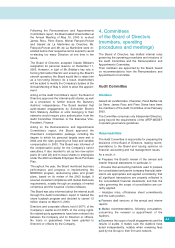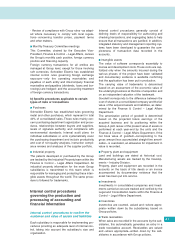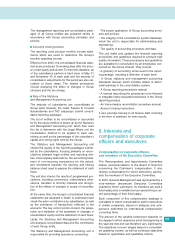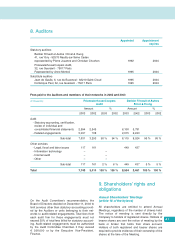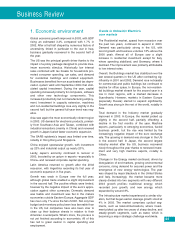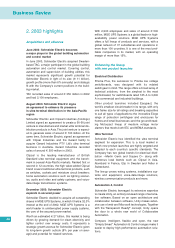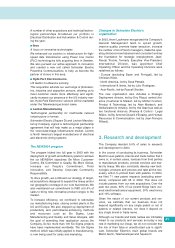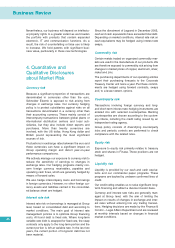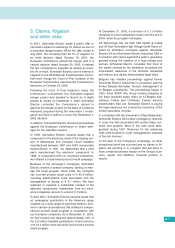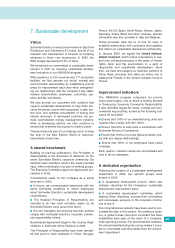APC 2003 Annual Report Download - page 41
Download and view the complete annual report
Please find page 41 of the 2003 APC annual report below. You can navigate through the pages in the report by either clicking on the pages listed below, or by using the keyword search tool below to find specific information within the annual report.
The management reporting and consolidation pack-
ages of all Group entities are prepared strictly in
accordance with Group accounting principles and
policies.
■Accounts closing process
The reporting units produce monthly income state-
ments which are used to determine the Group's
monthly operating income.
Effective from 2003, the consolidated financial state-
ments are produced 16 working days after the annu-
al or half-yearly period-end. To meet this deadline, all
of the subsidiaries perform a hard close at May 31
and November 30 of each year and the majority of
consolidation adjustments for the period are also cal-
culated at these dates. The related procedures
include analyzing the effect of changes in Group
structure and the tax charge.
■Role of the Statutory
and Management Accounting unit
The majority of subsidiaries are consolidated at
Group level; however, the Lexel, Square D, Crouzet
Automatismes and TAC subgroups submit consoli-
dated reporting packages.
The list of entities to be consolidated or accounted
for by the equity method is drawn up by the Statutory
and Management Accounting unit, which then uses
this list to determine with the Legal Affairs unit the
consolidation method to be applied to each sub-
sidiary, as well as the percentage of the subsidiary's
capital and voting rights held by the Group.
The Statutory and Management Accounting unit
checks the quality of the reporting packages submit-
ted by the subsidiaries, focusing primarily on recon-
ciliations between legal entities and reporting enti-
ties, intercompany eliminations, the accounting treat-
ment of non-recurring transactions for the period,
and movements between the opening and closing
balance sheet used to prepare the statement of cash
flows.
The unit also checks the results of programmed pro-
cedures, including conversions, intercompany elimi-
nations, transfers to minority interests and recogni-
tion of the effects of changes in scope of consolida-
tion.
At the same time, the Group's consolidated financial
statements are analyzed in detail, to understand and
check the main contributions by subsidiaries, as well
as the substance of transactions reflected in the
accounts. The key control points concern the prepa-
ration and validation of the statement of changes in
shareholders' equity and the statement of cash flows.
Lastly, the Statutory and Management Accounting
unit analyzes consolidated data and the contribution
of each Group entity.
The Statutory and Management Accounting unit is
responsible for providing assurance concerning:
- The proper application of Group accounting princi-
ples and policies.
- The integrity of the consolidation system database,
which the unit is responsible for administering and
maintaining.
- The quality of accounting processes and data.
The unit drafts and updates the financial reporting
procedures and guidelines required to produce high
quality information. These procedures and guidelines
are available for consultation by all employees con-
cerned on the Group intranet. They include:
- A glossary of accounting terms used in the report-
ing package, including a definition of each term.
- A Group statutory and management accounting
standards manual, which includes details of debit /
credit pairings in the consolidation system.
- A Group reporting procedures manual.
- A manual describing the procedures to be followed
to integrate newly-acquired businesses in the Group
reporting process.
- An intercompany reconciliation procedure manual.
- Account closing instructions.
It also provides training to all finance staff, including
in the form of seminars for new recruits.
6. Interests and
compensation of corporate
officers and executives
Compensation of corporate officers
and members of the Executive Committee
The Remunerations and Appointments Committee
makes recommendations to the Board of Directors
concerning the Chairman’s compensation. It also
reviews compensation for senior executives, particu-
larly the members of the Executive Committee.
In 2003, General Management was represented by a
nine-member (maximum) Executive Committee
chaired by Henri Lachmann. Its members are paid a
fixed salary plus a variable bonus representing a cer-
tain percentage of their fixed salary.
Each component of this compensation package is
calculated to match compensation paid to executives
in similar companies, based on analyses and com-
parisons performed by international compensation
consulting firms.
The amount of the variable component depends on
the degree to which objectives set at the beginning of
the year are met and can therefore vary significantly.
The objectives concern targets based on consolidat-
ed operating income, as well as individual objectives
based on quantitative and qualitative criteria.
39






